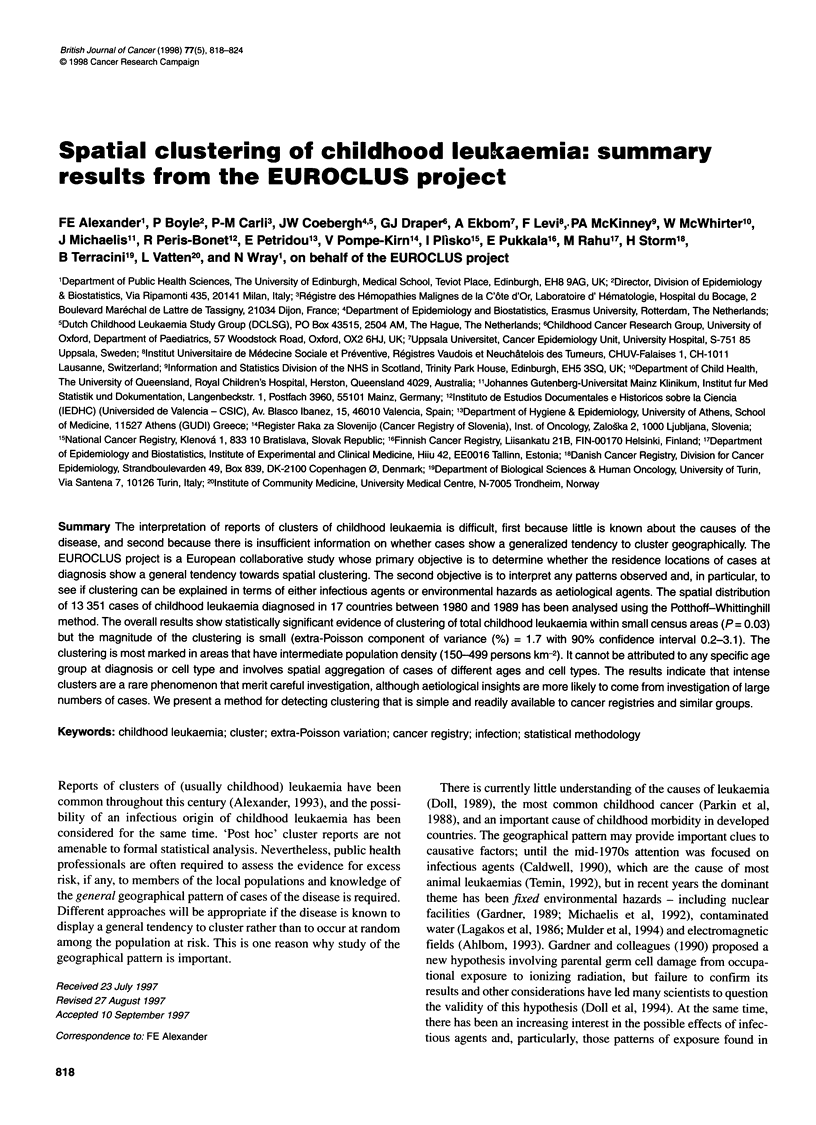Abstract
The interpretation of reports of clusters of childhood leukaemia is difficult, first because little is known about the causes of the disease, and second because there is insufficient information on whether cases show a generalized tendency to cluster geographically. The EUROCLUS project is a European collaborative study whose primary objective is to determine whether the residence locations of cases at diagnosis show a general tendency towards spatial clustering. The second objective is to interpret any patterns observed and, in particular, to see if clustering can be explained in terms of either infectious agents or environmental hazards as aetiological agents. The spatial distribution of 13351 cases of childhood leukaemia diagnosed in 17 countries between 1980 and 1989 has been analysed using the Potthoff-Whittinghill method. The overall results show statistically significant evidence of clustering of total childhood leukaemia within small census areas (P=0.03) but the magnitude of the clustering is small (extra-Poisson component of variance (%) = 1.7 with 90% confidence interval 0.2-3.1). The clustering is most marked in areas that have intermediate population density (150-499 persons km[-2]). It cannot be attributed to any specific age group at diagnosis or cell type and involves spatial aggregation of cases of different ages and cell types. The results indicate that intense clusters are a rare phenomenon that merit careful investigation, although aetiological insights are more likely to come from investigation of large numbers of cases. We present a method for detecting clustering that is simple and readily available to cancer registries and similar groups.
Full text
PDF






Selected References
These references are in PubMed. This may not be the complete list of references from this article.
- Ahlbom A., Feychting M., Koskenvuo M., Olsen J. H., Pukkala E., Schulgen G., Verkasalo P. Electromagnetic fields and childhood cancer. Lancet. 1993 Nov 20;342(8882):1295–1296. doi: 10.1016/0140-6736(93)92384-6. [DOI] [PubMed] [Google Scholar]
- Alexander F. E. Viruses, clusters and clustering of childhood leukaemia: a new perspective? Eur J Cancer. 1993;29A(10):1424–1443. doi: 10.1016/0959-8049(93)90016-9. [DOI] [PubMed] [Google Scholar]
- Doll R., Evans H. J., Darby S. C. Paternal exposure not to blame. Nature. 1994 Feb 24;367(6465):678–680. doi: 10.1038/367678a0. [DOI] [PubMed] [Google Scholar]
- Gardner M. J., Snee M. P., Hall A. J., Powell C. A., Downes S., Terrell J. D. Results of case-control study of leukaemia and lymphoma among young people near Sellafield nuclear plant in West Cumbria. BMJ. 1990 Feb 17;300(6722):423–429. doi: 10.1136/bmj.300.6722.423. [DOI] [PMC free article] [PubMed] [Google Scholar]
- Greaves M. F., Alexander F. E. An infectious etiology for common acute lymphoblastic leukemia in childhood? Leukemia. 1993 Mar;7(3):349–360. [PubMed] [Google Scholar]
- Greaves M. F. Speculations on the cause of childhood acute lymphoblastic leukemia. Leukemia. 1988 Feb;2(2):120–125. [PubMed] [Google Scholar]
- Kaatsch P., Kaletsch U., Krummenauer F., Meinert R., Miesner A., Haaf G., Michaelis J. Case control study on childhood leukemia in Lower Saxony, Germany. Basic considerations, methodology, and summary of results. Klin Padiatr. 1996 Jul-Aug;208(4):179–185. doi: 10.1055/s-2008-1046470. [DOI] [PubMed] [Google Scholar]
- Kinlen L. J., Dickson M., Stiller C. A. Childhood leukaemia and non-Hodgkin's lymphoma near large rural construction sites, with a comparison with Sellafield nuclear site. BMJ. 1995 Mar 25;310(6982):763–768. doi: 10.1136/bmj.310.6982.763. [DOI] [PMC free article] [PubMed] [Google Scholar]
- Kinlen L. J. Epidemiological evidence for an infective basis in childhood leukaemia. Br J Cancer. 1995 Jan;71(1):1–5. doi: 10.1038/bjc.1995.1. [DOI] [PMC free article] [PubMed] [Google Scholar]
- Kinlen L. Evidence for an infective cause of childhood leukaemia: comparison of a Scottish new town with nuclear reprocessing sites in Britain. Lancet. 1988 Dec 10;2(8624):1323–1327. doi: 10.1016/s0140-6736(88)90867-7. [DOI] [PubMed] [Google Scholar]
- Michaelis J., Keller B., Haaf G., Kaatsch P. Incidence of childhood malignancies in the vicinity of west German nuclear power plants. Cancer Causes Control. 1992 May;3(3):255–263. doi: 10.1007/BF00124259. [DOI] [PubMed] [Google Scholar]
- Mulder Y. M., Drijver M., Kreis I. A. Case-control study on the association between a cluster of childhood haematopoietic malignancies and local environmental factors in Aalsmeer, The Netherlands. J Epidemiol Community Health. 1994 Apr;48(2):161–165. doi: 10.1136/jech.48.2.161. [DOI] [PMC free article] [PubMed] [Google Scholar]
- Oliver M. A., Muir K. R., Webster R., Parkes S. E., Cameron A. H., Stevens M. C., Mann J. R. A geostatistical approach to the analysis of pattern in rare disease. J Public Health Med. 1992 Sep;14(3):280–289. [PubMed] [Google Scholar]
- Parkin D. M., Clayton D., Black R. J., Masuyer E., Friedl H. P., Ivanov E., Sinnaeve J., Tzvetansky C. G., Geryk E., Storm H. H. Childhood leukaemia in Europe after Chernobyl: 5 year follow-up. Br J Cancer. 1996 Apr;73(8):1006–1012. doi: 10.1038/bjc.1996.197. [DOI] [PMC free article] [PubMed] [Google Scholar]
- Petridou E., Alexander F. E., Trichopoulos D., Revinthi K., Dessypris N., Wray N., Haidas S., Koliouskas D., Kosmidis H., Piperopoulou F. Aggregation of childhood leukemia in geographic areas of Greece. Cancer Causes Control. 1997 Mar;8(2):239–245. doi: 10.1023/a:1018480515690. [DOI] [PubMed] [Google Scholar]
- Ross J. A., Potter J. D., Robison L. L. Infant leukemia, topoisomerase II inhibitors, and the MLL gene. J Natl Cancer Inst. 1994 Nov 16;86(22):1678–1680. doi: 10.1093/jnci/86.22.1678. [DOI] [PubMed] [Google Scholar]
- Rothman K. J. A sobering start for the cluster busters' conference. Am J Epidemiol. 1990 Jul;132(1 Suppl):S6–13. doi: 10.1093/oxfordjournals.aje.a115790. [DOI] [PubMed] [Google Scholar]
- Stiller C. A., Boyle P. J. Effect of population mixing and socioeconomic status in England and Wales, 1979-85, on lymphoblastic leukaemia in children. BMJ. 1996 Nov 23;313(7068):1297–1300. doi: 10.1136/bmj.313.7068.1297. [DOI] [PMC free article] [PubMed] [Google Scholar]


